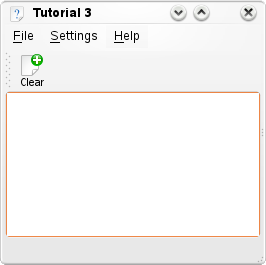Development/Tutorials/Using KActions: Difference between revisions
m (Create 'skellington' :)) |
(Add all the code. Still need to copy in the text.) |
||
| Line 1: | Line 1: | ||
[[image:introtokdetutorial3.png|frame|center]] | |||
==Abstract== | ==Abstract== | ||
We're going to introduce the concept of actions. Actions are a unified way of supplying the user with ways to interact with your program. Say, for example, we want to let the user clear the text box by clicking a button in the toolbar, from an option in the File menu or through a keyboard shortcut; we can provide all of those through one {{class|KAction}}. | |||
==Prerequisites== | ==Prerequisites== | ||
* [[Development/Tutorials/Programming_Tutorial_KDE_4/Using_KMainWindow|Tutorial 2 - KMainWindow]] | * [[Development/Tutorials/Programming_Tutorial_KDE_4/Using_KMainWindow|Tutorial 2 - KMainWindow]] | ||
==KAction== | |||
===Creating Your Own=== | |||
===KStandardAction=== | |||
==The Code== | |||
===mainwindow.h=== | |||
<code cppqt n> | |||
#ifndef MAINWINDOW_H | |||
#define MAINWINDOW_H | |||
#include <KMainWindow> | |||
#include <KTextEdit> | |||
class MainWindow : public KMainWindow | |||
{ | |||
public: | |||
MainWindow(QWidget *parent=0); | |||
private: | |||
KTextEdit* textArea; | |||
void setupActions(); | |||
}; | |||
#endif | |||
</code> | |||
===mainwindow.cpp=== | |||
<code cppqt n> | |||
#include "mainwindow.h" | |||
#include <KApplication> | |||
#include <KAction> | |||
#include <KStandardAction> | |||
MainWindow::MainWindow(QWidget *parent) : KMainWindow(parent) | |||
{ | |||
textArea = new KTextEdit; | |||
setCentralWidget(textArea); | |||
setupActions(); | |||
} | |||
void MainWindow::setupActions() | |||
{ | |||
KStandardAction::quit(kapp, SLOT(quit()), actionCollection()); | |||
KAction* clearAction = new KAction(actionCollection(), "clear"); | |||
clearAction->setText("Clear"); | |||
clearAction->setIcon(KIcon("filenew")); | |||
clearAction->setShortcut(Qt::CTRL+Qt::Key_W); | |||
connect(clearAction, SIGNAL(triggered(bool)), | |||
textArea, SLOT(clear())); | |||
setupGUI(); | |||
} | |||
</code> | |||
===main.cpp=== | |||
<code cppqt n> | |||
#include <KApplication> | |||
#include <KAboutData> | |||
#include <KCmdLineArgs> | |||
#include "mainwindow.h" | |||
int main (int argc, char *argv[]) | |||
{ | |||
KAboutData aboutData( "tutorial3", "Tutorial 3", | |||
"1.0", "A simple text area using KAction etc.", KAboutData::License_GPL, | |||
"(c) 2006" ); | |||
KCmdLineArgs::init( argc, argv, &aboutData ); | |||
KApplication app; | |||
MainWindow* window = new MainWindow(); | |||
window->show(); | |||
return app.exec(); | |||
} | |||
</code> | |||
==Putting the actions in the menus and toolbars== | |||
===XMLGUI=== | |||
===tutorial3ui.rc=== | |||
<code xml n> | |||
<!DOCTYPE kpartgui SYSTEM "kpartgui.dtd"> | |||
<kpartgui name="tutorial3" version="1"> | |||
<ToolBar name="mainToolBar" > | |||
<text>Main Toolbar</text> | |||
<Action name="clear" /> | |||
</ToolBar> | |||
<MenuBar> | |||
<Menu name="file" > | |||
<text>&File</text> | |||
<Action name="clear" /> | |||
</Menu> | |||
</MenuBar> | |||
</kpartgui> | |||
</code> | |||
==CMake== | ==CMake== | ||
<code ini n> | <code ini n> | ||
PROJECT(tutorial3) | |||
FIND_PACKAGE(KDE4 REQUIRED) | |||
INCLUDE_DIRECTORIES( ${KDE4_INCLUDES} ) | |||
SET(tutorial3_SRCS | |||
main.cpp | |||
mainwindow.cpp | |||
) | |||
KDE4_ADD_EXECUTABLE(tutorial3 ${tutorial3_SRCS}) | |||
TARGET_LINK_LIBRARIES( tutorial3 ${KDE4_KDEUI_LIBS}) | |||
install(TARGETS tutorial3 DESTINATION ${BIN_INSTALL_DIR}) | |||
install( FILES tutorial3ui.rc DESTINATION ${DATA_INSTALL_DIR}/tutorial3 ) | |||
</code> | </code> | ||
==Moving On== | ==Moving On== | ||
Revision as of 20:41, 3 January 2007

Abstract
We're going to introduce the concept of actions. Actions are a unified way of supplying the user with ways to interact with your program. Say, for example, we want to let the user clear the text box by clicking a button in the toolbar, from an option in the File menu or through a keyboard shortcut; we can provide all of those through one KAction.
Prerequisites
KAction
Creating Your Own
KStandardAction
The Code
mainwindow.h
- ifndef MAINWINDOW_H
- define MAINWINDOW_H
- include <KMainWindow>
- include <KTextEdit>
class MainWindow : public KMainWindow
{
public:
MainWindow(QWidget *parent=0);
private:
KTextEdit* textArea;
void setupActions();
};
- endif
mainwindow.cpp
- include "mainwindow.h"
- include <KApplication>
- include <KAction>
- include <KStandardAction>
MainWindow::MainWindow(QWidget *parent) : KMainWindow(parent)
{
textArea = new KTextEdit;
setCentralWidget(textArea);
setupActions();
}
void MainWindow::setupActions()
{
KStandardAction::quit(kapp, SLOT(quit()), actionCollection());
KAction* clearAction = new KAction(actionCollection(), "clear");
clearAction->setText("Clear");
clearAction->setIcon(KIcon("filenew"));
clearAction->setShortcut(Qt::CTRL+Qt::Key_W);
connect(clearAction, SIGNAL(triggered(bool)),
textArea, SLOT(clear()));
setupGUI();
}
main.cpp
- include <KApplication>
- include <KAboutData>
- include <KCmdLineArgs>
- include "mainwindow.h"
int main (int argc, char *argv[])
{
KAboutData aboutData( "tutorial3", "Tutorial 3",
"1.0", "A simple text area using KAction etc.", KAboutData::License_GPL,
"(c) 2006" );
KCmdLineArgs::init( argc, argv, &aboutData );
KApplication app;
MainWindow* window = new MainWindow();
window->show();
return app.exec();
}
XMLGUI
tutorial3ui.rc
<!DOCTYPE kpartgui SYSTEM "kpartgui.dtd">
<kpartgui name="tutorial3" version="1">
<ToolBar name="mainToolBar" >
<text>Main Toolbar</text>
<Action name="clear" />
</ToolBar>
<MenuBar>
<Menu name="file" >
<text>&File</text>
<Action name="clear" />
</Menu>
</MenuBar>
</kpartgui>
CMake
PROJECT(tutorial3)
FIND_PACKAGE(KDE4 REQUIRED)
INCLUDE_DIRECTORIES( ${KDE4_INCLUDES} )
SET(tutorial3_SRCS
main.cpp
mainwindow.cpp
)
KDE4_ADD_EXECUTABLE(tutorial3 ${tutorial3_SRCS})
TARGET_LINK_LIBRARIES( tutorial3 ${KDE4_KDEUI_LIBS})
install(TARGETS tutorial3 DESTINATION ${BIN_INSTALL_DIR})
install( FILES tutorial3ui.rc DESTINATION ${DATA_INSTALL_DIR}/tutorial3 )
